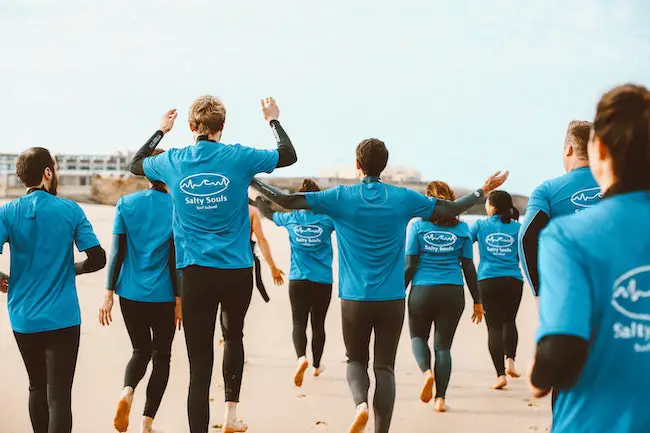Barefoot training is all the rage lately. But what exactly is it, and why are people so interested in it? In this blog post, we will discuss the basics of barefoot training and how you can benefit from it. We’ll also answer some common questions about barefoot training, such as whether or not you need to go completely barefoot to reap the benefits. So if you’re curious about this growing trend, keep reading!

What is barefoot training, and why is it becoming so popular?
Barefoot training is a type of exercise that is performed without the use of shoes. Proponents of barefoot training believe that it helps to improve balance and proprioception, and can also reduce the risk of injuries such as shin splints and plantar fasciitis. In addition, barefoot training is said to promote a more natural gait and lessen the impact on joints. While barefoot training has long been used by runners and other athletes, it has only recently gained popularity among the general public.
As people have become more aware of the benefits of barefoot training, more gyms and fitness studios are offering classes and programs dedicated to this type of exercise. In addition, there are now a number of shoes on the market that have been designed for barefoot training, making it easier than ever for people to give this type of exercise a try. Whether you are looking to improve your balance or reduce your risk of injuries, barefoot training may be worth considering.
What are the benefits of barefoot training for surfers?
As any surfer knows, the key to success is a strong connection with the board. This is why many surfers choose to do fitness training barefoot. By going barefoot, they are able to gain a better sense of feel for the board beneath their feet. This improved sense of touch can help them to make faster and more accurate turns. In addition, barefoot training can also help to strengthen the muscles in the feet and lower legs.
Recommended: How To Stay Fit & Healthy At Any Age – Laird Hamilton & Joe Rogan
Choosing to train barefoot is an easy and highly effective way to reconnect with how our ancestors moved. When you are training barefoot, the stabilizer muscles and connective tissues in your feet are active. When you are wearing shoes, these muscles and tissue are inactive. Going barefoot leads to an improvement in overall body awareness, and stability and improves overall balance.
Training barefoot also points out your weak areas, allowing you to improve these areas. Grounding, or being in direct contact with the earth’s surface, has been incredibly helpful to improve your sense of balance. (from Earthing: Health Implications of Reconnecting the Human Body to the Earth’s Surface Electrons).
How can you get started with barefoot training yourself?
Before you begin, it’s important to understand that barefoot training is not only about running long distances or doing things that are intense. It’s about starting with small changes and gradually adapting to being barefoot more often. With that in mind, here are a few tips on how to get started with barefoot training:
- Start slow and listen to your body. When you first start going barefoot, it’s important to take things slowly. Listen to your body and only do what feels comfortable. If you start to feel any pain, stop immediately and rest.
- Build up gradually. Once you’re comfortable walking around barefoot, you can start to gradually build up the amount of time you spend each day. Start with 10 minutes and then increase the time as your body adapts.
- Find a soft surface. It’s important to find a soft surface to walk on when you’re starting out with barefoot training. This could be grass, sand, or even a padded mat. Avoid concrete or other hard surfaces as they will be too tough on your feet.
- Do some stretches before you start. To help prevent injuries, it’s a good idea to do some stretches before you start walking around barefoot. Focus on stretching your calves, hamstrings, and feet.
Are there any risks associated with barefoot training?
When it comes to working out, there are a variety of different opinions on the best way to get the most out of your body. Some people swear by the benefits of barefoot training, while others prefer to stick to traditional methods. So, what does the research say? Are there any risks associated with barefoot training?
The jury is still out on this one. Some studies have shown that barefoot training can help improve balance and proprioception, while others have found no significant difference between barefoot and shod runners. As for injury risk, one study found that runners who switch from traditional shoes to minimalist shoes are more likely to experience Achilles tendon injuries.
Learn more: Effect of Minimalist Footwear on Running Efficiency
However, it’s worth noting that this study was small and only looked at experienced runners; the risk for novice runners may be different. Ultimately, more research is needed to determine the risks and benefits of barefoot training. Until then, it’s up to each individual to decide whether or not they want to give it a try.
FAQs about barefoot training
Q: Will I be able to run as fast barefoot as I can in shoes?
A: It’s unlikely. Most people who switch to barefoot running will see a decrease in their running speed at first. This is because you’re using different muscles when you run barefoot, and it takes time to adjust.
Q: How often should I do barefoot training?
A: It’s up to you. Some people like to do it every day, while others only do it once or twice a week. Listen to your body and do what feels comfortable.
Q: Can I do other exercises besides running barefoot?
A: Yes! There are a variety of different exercises you can do barefoot, including walking, yoga, and Pilates.
Q: I have diabetes/high blood pressure/ heart condition. Can I still do barefoot training?
A: You should always check with your doctor before starting any new exercise regime, especially if you have a medical condition. That being said, there are many people with diabetes/high blood pressure/heart conditions who safely do barefoot training.
Q: I have sensitive feet. Will barefoot training be too painful?
A: It’s possible. Some people with sensitive feet find that they can only do barefoot training on a soft surface, such as grass or sand. Others find that they can gradually build up to walking on harder surfaces, such as concrete. Listen to your body and don’t push yourself if it’s too painful.
Q: I’m pregnant. Can I do barefoot training?
A: You should check with your doctor before starting any new exercise regime during pregnancy, but many women find that barefoot training is a safe and comfortable way to stay in shape.
ULTIMATE Mobility Routine for SURFERS
Recent Posts
Ever wondered what it's like to be a professional surfer? Catch epic waves, travel to exotic locations, and live the dream beach bum life, right? Well, there's definitely a lot more to it than that,...
Gnarly Wipeouts and Barnacle Battles: A Day Out West Oz with Nathan Florence
Big wave charger Nathan Florence is no stranger to taking on the mother nature's fury at some of the world's most intimidating breaks. This time, however, a laid-back session with buddy Ned Hart at a...
